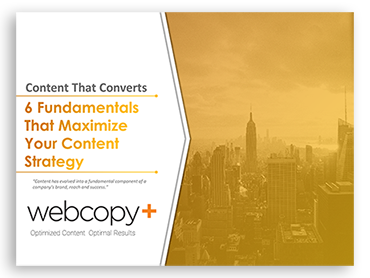
Product web pages are the “money” pages of your website. They’re where you convert lookers to buyers. If you want to maximize conversions, it’s not enough to merely cut and paste manufacturer product descriptions onto your product pages. You need to structure and write product information specifically for the web. Here are a few tips.
Benefits, Benefits, Benefits
When you drill down to your product pages, you might be tempted to list lengthy and detailed feature descriptions, especially if it’s a fairly technical product. While it’s important to provide detailed feature information, it’s even more important to stress benefits.
Mountain Equipment Coop (MEC) does a good job providing both features and benefits of their products on their product pages. Take this example of a youth down jacket. In their description bullet points, they list not only the features (e.g. “310-thread count nylon taffeta”) but also the benefits of those features (e.g. “won’t allow down to escape”). Detailed features (or product specifications) are included in an easy-to-read table under a separate tab.
In addition to listing product benefits, be sure to list company benefits on product pages too. Benefits like free shipping and no-hassle returns should be included. Remember, your product page might be the first page of your website that people see, especially if they arrive via organic search. Don’t assume people have gleaned company benefit information from other pages on your site.
MEC also does this well. They list benefits such as their “rocksolid guarantee,” “price protection,” “shipping info” and “product development” on their product pages, just below the product description.
Make Product Pages Search Engine Friendly
Product pages are a great opportunity to make the most of long-tail Google searches. When you name your products or describe product categories, be sure to use good search keywords and keyword phrases.
For example, Mark’s uses the title “Denver Hayes Leather Riding Boot” under the category of “Women’s Casual Boots” to describe this particular shoe. This is much more effective and descriptive than simply “shoe.” By including the brand name (Denver Hayes), the type of shoe (boot), the type of material (leather), and the target market (women), this page is much more likely to be picked up by organic search.
Resist the temptation to give your products or product categories innovative or cool names that people won’t intuitively think of when searching for your product.
Provide Social Proof
Although a big part of product pages is selling the product, another big part is making sure people feel comfortable buying from you. Testimonials, reviews, star ratings and online or in-store availability are all ways to reassure people you are a legitimate business and a safe place to shop.
Links to refund policies, guarantees, and delivery time estimates also provide reassurance. Also, make it easy for shoppers to ask questions by providing contact information or links on every page.
Use a Clear, Uncluttered Call to Action
Make sure your call to action is visible and clear. “Add to cart” and “buy now” buttons help eliminate ambiguity. Try to limit each product page to one call to action. Having multiple calls to action (e.g. “sign up for our newsletter” or “read our latest blog post”) may distract visitors from the purchase process.
Don’t Forget the Price
Make your pricing, and what it includes, as clear as possible. People are unlikely to click on the “buy now” button if they’re not clear on the cost or what it covers. Mail Chimp clearly outlines its different pricing plans with a description of what each plan includes. To help people decide, they also provide some guidance, e.g. “for frequent senders” or “for infrequent senders.”
If your product is at a higher price point, don’t be tempted to hide or downplay the price. Instead, use detailed product benefits to justify it.
Use Just the Right Amount of Copy
As with all types of copy, there are debates about how long product page copy should be. Longer copy can include more keywords, so you might get more long tail search hits. However, long product page copy can overwhelm visitors too. Shorter copy is easier for visitors to digest, but you might miss out on some search terms. A compromise is to use longer copy, but present it using bullet points, numbered lists or chunked text to make it less visually overwhelming.
Often, the right balance between long and short copy can only be ascertained by A/B testing, where two versions of the same page (one with short copy, one with long) are used to see which page results in better conversions.
Adopt a Straightforward Tone
While it might be appropriate to use a distinctive voice or tone for higher-level web pages, such as your home page or major category pages, you don’t want voice to get in the way of conversions on your product page. Most product page copy should be written in a straightforward tone, even if your brand is particularly quirky or cool.
Even luxury brands, such as Louis Vuitton, tend to keep voice to a minimum on their product pages. The Louis Vuitton site is all about feeling and storytelling, but they keep their product pages simple and to the point.
Follow these tips, and you’ll have a killer web product page. If you have thousands of product pages in need of improvement, don’t panic. This isn’t something you have to do all at once. Start by revising your top money-generating product pages and then work from there.






Leave a Reply